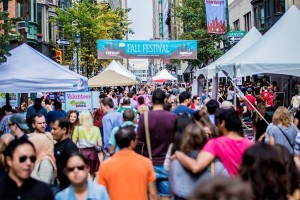Giant Papercut of Philadelphia Took 150 Hours or So

Photo courtesy of Emma Fried-Cassorla and Albert Yee
Papercutting is an ancient art form, with one papercut in China dating to the sixth century. Philadelphia’s Emma Fried-Cassorla picked it up pretty recently, and in a short order she’s produced a papercut of the entire city streets grid.
She’s giving it away as part of the anniversary of her Philly Love Notes blog, and the #whyilovephilly party on June 26. I chatted with her about how she came to take this overwhelming task.
How long have you been paper cutting?
Not very long. Before I started doing the small neighborhood ones, which I probably started three months ago, I had paper-cut maybe like seven times in my life.
Why did you pick it up recently?
I had seen a cool map paper cut done a couple years ago, so I just tried it out for a friend as a gift and it looked cool. A couple months ago I needed another side project, so I asked people if anyone wanted a free papercut so I could practice on that. I could practice on friends, give them something, and maybe sell them, or use them as a way to do a Kickstarter to raise money for Philly Love Notes.
What do you get out of papercutting?
It’s strange. I half-enjoy it, it’s kind of stressful, because I don’t want to screw up. But it’s a really nice time to enjoy my mind. Work is so busy and it’s so many moving parts that having that to go to is really nice. It wasn’t fun per se, but it was relaxing.
How many papercuts had you done before starting one of the entire city?
I think I had done about 15.
Why did you decide to do it?
It was a very spontaneous decision made one afternoon, where I said, “I should just try to cut the whole city.” The full size of the paper was 4 feet by 3 feet, and the final cut now is probably 3-and-a-half-feet tall by 2-feet wide. Basically, I just posted on Twitter and Facebook asking if anyone has the City Streets GIS layer, and a friend who works at OpenData sent it to me.
Then I just sent it to a printer and asked them to print it out on a really big piece of paper, and they only had one kind of paper because it was so big. It’s just printer paper. It’s not anything special. And, so, it just very conveniently worked. They printed out the map, and gave me a blank piece of paper the same size. So when I was cutting I was using the map on top as my guideline, and I cut out everything except for the streets. So I ended up with two copies.
How long did this take you to do?
It took five weeks working some nights and weekends, working around my job.
How often did you work on it?
I did it probably four days a week. 20 days, between 4 and 12 hours sometimes. It was probably an average of maybe six hours. It was not as many hours as I thought it was. Only 120 hours, 150 hours, maybe.
Did you know how much work it was going to be?
No. You know how Indy Hall has that catchphrase, “JFDI, Just Fucking Do it.” I started it and was like, “Shit. I guess I have to keep going.” I had no idea how much work it was going to be.
In what directions did you cut the streets?
I started from the south and I worked up and went west. And then I got to Center City, and I was like, I would be working for four hours and making very little useful progress, that I then moved to the Northeast. I then started working toward the middle, from the Northeast into North Philly, and the west from North Philly, because the paper shifted when I was cutting. So I had to work that all out in the center. It was kind of hard.
What were the most challenging neighborhoods?
Pennsport and Center City were horrible. Pennsport has the little side streets, but if things are all parallel, it makes it easier. Pennsport has all these diagonals and little small streets that don’t go all the way through, and all these tiny little streets that are going in weird directions.
Up in the Northeast, the roads become more circular. They’re not as straight. That’s harder to do with an X-Acto knife.
Yeah, I grew up on a horseshoe street in the far Northeast.
Uh-huh. They’re all like that.
Were there times you felt like you’d taken on too much?
Absolutely. It was physically painful to do after a while. I had to take breaks. There were a couple days where I said I can’t do this because my hand hurts.
Where did you complete most of this work?
I started on my kitchen table, and I quickly outgrew the limited space that I have in my apartment and started working at Indy Hall on nights and weekends.


